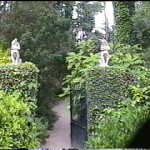Glenveagh Castle (Caislean Ghleann Breatha) was built after Captain John George Adair purchased 28,000 acres of land in County Donegal in 1859. Adair developed plans for a four-storey castle keep with surrounding gardens.
Adair is not much loved in County Donegal. To improve the beauty of his estate, he cleared the land of the existing tenants there, an eviction of 44 families (244 people). They were gone by the summer of 1861, many went to the workhouse in Letterkenny and others emigrated to Australia.
Adair’s castle was finished in 1873. He was only able to enjoy it for 12 years and died in 1885. Adair’s wife improved the castle and continued beautifying the gardens through the following years. She was known for entertaining prominent guests at the estate. In the spirit of her husband’s interest in hunting, she introduced Red Deer for hunting in the 1890s. Mrs. Adair spent her summers at the castle until she died in 1921, when the castle fell into a bit of disrepair. It was occupied at times then by opposing armies in the Irish Civil War.
Mr. Henry McIlhenny was an Irish-American from Philadelphia with roots in County Donegal. He was famous as an art and antique collector, world traveller, and socialite. McIlhenny was associated with the Philadelphia Art Museum for many years, serving as curator from 1939 to 1964. He became chairman of the museum in 1976.
McIlhenny had rented Glenveagh as a summer residence since 1933. In 1938, he bought the estate and restored the castle and its lands. He furnished both Glenveagh and his home in Rittenhouse Square (Philadelphia) with rare art and antique furnishings. He entertained many guests such as Greta Garbo, Charlie Chaplin, and Clark Gable at his Donegal estate.
In 1975, he gave the land to the Irish Republic to be developed as a National Park with the stipulation that he could live there for his lifetime. Then in 1983, he gifted the castle and gardens to Ireland. The National Park was opened in 1984, and the castle was open to the public in 1986.
Glenveagh National Park is one of the most popular attractions in County Donegal. More information can be found at:










